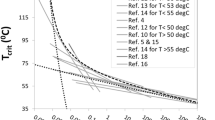Abstract
We describe a new model for laser-induced retinal damage. Our treatment is prompted by the failure of the traditional approach to accurately describe the image size dependence of laser-induced retinal injuries and by a recently reported study which demonstrated that laser injuries to the retina might not appear for up to 48 h post exposure.
We propose that at threshold a short-duration, laser-induced, temperature rise melts the membrane of the melanosomes found in the pigmented retinal epithelial cells. This results in the generation of free radicals which initiate a slow chain reaction. If more than a critical number of radicals are generated then cell death may occur at a time much later than the return of the retina to body temperature.
We show that the equations consequent upon this mechanism result in a good fit to the recent image size data although more detailed experimental data for rate constants of elementary reactions is still required.
This paper contributes to the current understanding of damage mechanisms in the retina and may facilitate the development of new treatments to mitigate laser injuries to the eye. The work will also help minimize the need for further animal experimentation to set laser eye safety standards.
Similar content being viewed by others
References
Birngruber, R. (1980). Thermal modelling in biological tissues, in Lasers in Biology and Medicine, NATO ASI Series A—Life Sciences 34, F. Hillenkamp, R. Patresi and C. A. Sacchi (Eds), New York: Plenum Press, pp. 77–97.
Birngruber, R., F. Hillenkamp and V.-P. Gabel (1985). Theoretical investigations of laser thermal retinal injury. Health Phys. 48, 781–796.
Boulton, M., A. Dontsov, J. Jarvis-Evans, M. Ostrovsky and D. Svistunenko (1993). Lipofuscin is a photoinducible free radical generator. J. Photochem. Photobiol. B 19, 201–204.
Cope, F. W., R. J. Sever and B. D. Polis (1963). Reversible free radical generation in the melanin granules of the eye by visible light. Arch. Biochem. Biophys. 100, 171–177.
Gan, E. V., H. F. Haberman and I. A. Menon (1974). Oxidation of NADH by melanin and melanoproteins. Biochim. Biophys. Acta 370, 62–69.
Gerstman, B. S. and R. D. Glickman (1999). Activated rate processes and a specific biochemical mechanism for explaining delayed laser induced thermal damage to the retina. J. Biomed. Opt. 4, 345–351.
Glickman, R. D., S. L. Jacques, J. A. Schwartz, T. Rodriguez, K. W. Lam and G. Buhr (1996). Photodisruption increases the free radical reactivity of melanosomes isolated from retinal pigment epithelium. SPIE 2681, 460–467.
Glickman, R. D., M. Vendal, M. A. Gonzales and N. Kumar (1999). Intracellular photochemical reactions in the RPE cell exhibit a wavelength dependence that resembles the action spectrum of melanin. Proc. SPIE 3601, 94–101.
Gursky, O. and D. Atkinson (1996). High-and low-temperature unfolding of human high-density apolipoprotein A-2. Protein Sci. 5, 1874–1882.
Henriques, F. C. (1947). Studies of thermal injury. Arch. Pathol. 43, 489–502.
Krasowska, A., D. Rosiak, K. Szkapiak and M. Lukaszewicz (2000). Chemiluminescence detection of peroxyl radicals and comparison of antioxidant activity of phenolic compounds. Curr. Top. Biophys. 24, 89–95.
Margenau, H. and G. M. Murphy (1943). The Mathematics of Physics and Chemistry, New York: Van Nostrand, Section 7.14 ff.
Matthes, R. and D. Sliney (Eds) (1998). Measurement of Optical Radiation Hazards. A Reference Book, Vienna: ICNIRP, pp. 16–18.
McKenzie, A. L. (1990). Physics of thermal processes in laser tissue interaction. Phys. Med. Biol. 35, 1175–1209.
Sarna, T. (1992). Properties and function of the ocular melanin—a photophysical view. J. Photochem. Photobiol. B 12, 215–258.
Thompson, C. R., B. S. Gerstman, S. L. Jacques and M. E. Rogers (1996). Melanin granule model for laser-induced thermal damage in the retina. Bull. Math. Biol. 58, 513–533.
Till, S. J., B. S. Gerstman, R. C. Hollins, J. Till, P. K. Milsom, G. Rowlands and P. M. Hallett (2002). Modelling laser-induced retinal damage, in Proceedings of Laser Bioeffects Meeting, Paris: H.I.A. Val de Grâce.
Toth, C., E. Worniallo, S. F. Bailey, B. A. Rockwell and C. P. Cain (1999). Methods of achieving three-dimensional reconstruction of tissue at the ultrastructural level demonstrating the distribution of melanosomes within retinal pigment epithelium. Proc. SPIE 3601, 11–21.
Watson, G. N. (1958). A Treatise on the Theory of Bessel Functions, Cambridge University Press, p. 395.
Welch, A. J. and G. D. Polhamus (1984). Measurement and prediction of thermal injury in the retina of the Rhesus Monkey. IEEE Trans. Biomed. Eng. BME 31(10), 633–644.
Wiegand, R. D., J. G. Jose, L. M. Rapp and R. E. Anderson (1984). Free radicals and damage to ocular tissues, in Free Radicals in Molecular Biology, Aging and Disease, D. Armstrong, R. S. Sohal, R. G. Cutler and T. F. S. Raven (Eds), New York: Raven, pp. 317–353.
Zhu, K., A. Jutila and P. K. J. Kinnunen (2000). Steady state and time resolved effects of guanidine hydrochloride on the structure of Humicola lanuginosa lipase revealed by fluorescence spectroscopy. Protein Sci. 9, 598–609.
Zuclich, J. A., P. R. Edsall, D. J. Lund, B. E. Stuck, R. C. Hollins, S. J. Till, P. A. Smith, L. N. McLin and P. Kennedy (2000). Variation of laser induced retinal-damage threshold with retinal image size. J. Laser Appl. 12, 74–80.
Author information
Authors and Affiliations
Corresponding author
Additional information
Unemployed; no address available.
Rights and permissions
About this article
Cite this article
Till, S.J., Till, J., Milsom, P.K. et al. A new model for laser-induced thermal damage in the retina. Bull. Math. Biol. 65, 731–746 (2003). https://doi.org/10.1016/S0092-8240(03)00028-4
Received:
Accepted:
Issue Date:
DOI: https://doi.org/10.1016/S0092-8240(03)00028-4




